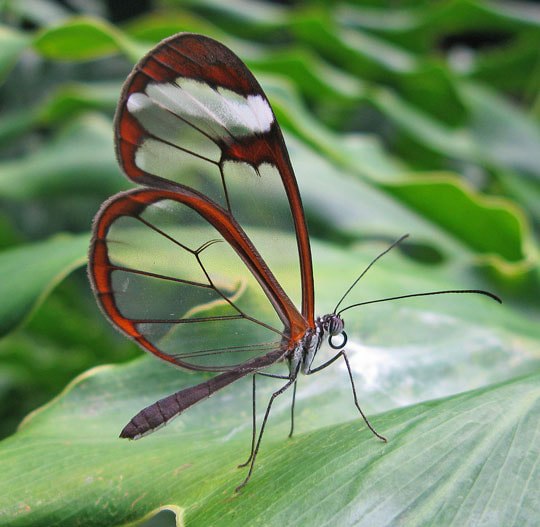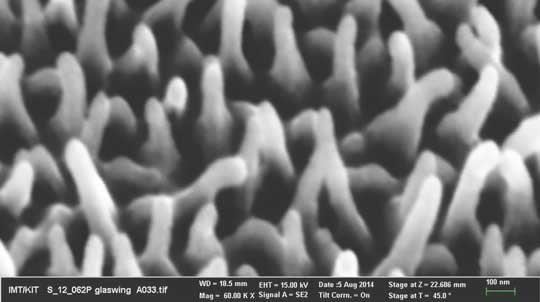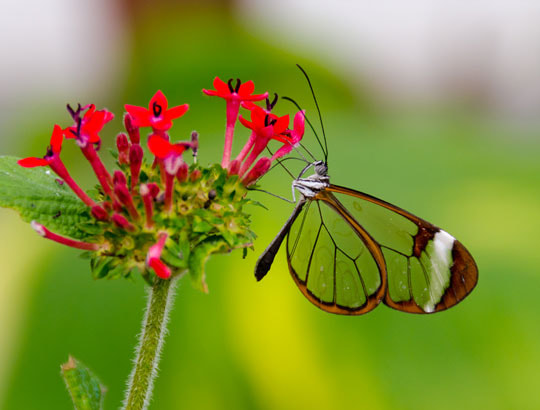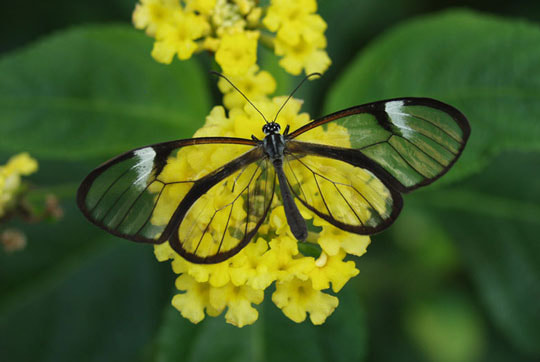|
I consider some creatures to be Awesome Animals simply because they are amazingly beautiful. Glasswing butterflies are a great example. As it turns out, though, these insects have plenty of other fascinating characteristics besides their beauty. What the heck is a Glasswing Butterfly? Glasswing butterflies include about 370 species in a subfamily called Danainae. These butterflies live throughout Central and South America. They are called glasswing because at least part of their wings are transparent, like glass. Amazing facts about Glasswing Butterflies Let's talk about those crazy transparent wings, including the how and the why. How. Here is an oversimplified statement: they are transparent because they don't reflect very much light. Instead of being reflected, light passes right through them (including infrared, visible light, and ultraviolet). As you probably know, the colors of other butterfly wings are due to the light being reflected and scattered in certain ways by the tiny structures on the wing surface. Well, the nanostructure of glasswing butterfly wings is different. Instead of having orderly rows of microscopic structures, these butterfly wings have randomly-scattered pillars, each pillar 50 to 100 times thinner than a human hair. Not only are these pillars randomly scattered, they are also of different heights and thicknesses. All of this randomness has the effect of redirecting the light through the wings instead of reflecting it. See these random pillars below. Amazingly, these wing surfaces are much less reflective than glass, and scientists are studying them to help develop less reflective coverings for screens. You know... such as the screen you are looking at right now as you read this text. Not only that, but these surfaces are extremely water repellant. This is important to the butterflies because, if raindrops stick to their wings, the weight of the water will keep them from flying. As if that weren't cool enough, the wing surfaces are self cleaning. So, glasswing butterflies might help us develop screens that can be viewed even in direct sunlight, and repel water, and are self cleaning! Now let's look at why they have transparent wings. The main predators of glasswing butterflies are birds. Birds typically catch butterflies in mid-flight, but these clear wings make it extremely difficult to track the butterflies' movements during flight. This kind of camouflage—transparency—is extremely rare in nature, making these butterflies pretty darn special. But that's not the only defense these insects have against predators. Here's one that's REALLY cool. Glasswing butterflies give their mates a very special nuptial gift—poison. You read that correctly. Poison. Here's how it works. Male glasswing butterflies have a super-duper sense of smell. Why? So that they can locate certain flowers called asters. These particular asters are special because they contain seriously-lethal poisons called pyrrolizidine alkaloids. So, the males gobble up these poisons and store them in their body. This makes the male butterfly really nasty-tasting and toxic to predators. Then, when the male finds a suitable female, he offers these poisons as a gift. That's a romantic way of saying that the toxic nectar from the flowers is converted to pheromones that attract the females. Not only that, but the toxins are concentrated in the male's body in a spermatophore (a package containing sperm), which is transferred to the female if she finds the male attractive. This poison goes into the female's body and makes her nasty-tasting and toxic to predators. What a generous gift. It doesn't end there! The sperm cells in the spermatophore fertilize the female's eggs, and the toxin even makes the eggs nasty-tasting and toxic to predators. And... guess where the females lay their eggs... they lay them on those same types of aster plants. So, when the larvae hatch out, they consume the plant so that they become caterpillars that are nasty-tasting and toxic to predators. The bottom line... glasswing butterflies are pretty to look at, but don't eat them. Also, female glasswing butterflies consider an offering pf poison to be very romantic. Check out this video about glasswing butterflies giving the nuptial gift of poison Here's another fascinating aspect of glasswing butterfly mating behavior. The males take part in a behavior called lekking. This is kind of like a buffet for females, a place for one-stop shopping for a suitable male. The males congregate together in one area, then each of them establishes his own little territory within that area—a territory he defends aggressively from the other males. With numerous males concentrated in one small area, when they all release their love pheromones, the concentrated pheromones attract females from great distances. The females converge on the lekking area and shop around, choosing a male based upon the quality of his little territory. So, Glasswing Butterflies deserve a place in the D.A.H.O.F. (Devine Animal Hall of Fame). FUN FACT: The word devine originated sometime between 1275 and 1325. Originally it meant "godlike; characteristic of or befitting a deity." It came from the Latin divus, "of or belonging to a god, inspired, prophetic." As with many such words, it gradually developed a broader meaning, and by the late 1400s it was being used to mean "excellent in the highest degree, heavenly." In that sense, it is still in use today. So, divine is another way to say awesome! Photo Credits:
Glasswing butterfly #1 - David Tiller, Wikimedia Commons Microscope view of wing structure - Radwanul Hasan Siddique via Newatlas Glasswing butterfly on red flowers - Scott Wilie, Wikimedia Commons Glasswing butterfly on yellow flowers - Reiman Gardens Glasswing butterflies mating - EcoQueenFaye
1 Comment
Vinnie
5/22/2023 02:51:14 am
Hi Stan, excellent article on the Glasswinged Butterfly.
Reply
Leave a Reply. |
Stan's Cogitations
Everyone needs a creative outlet. That's why I write. Archives
July 2024
|






 RSS Feed
RSS Feed